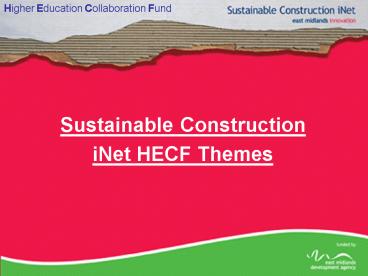Sustainable Construction iNet HECF Themes - PowerPoint PPT Presentation
1 / 9
Title:
Sustainable Construction iNet HECF Themes
Description:
... for new-build housing, by preparing house designs for Climate Change. ... House design changes (Mediterranean in 50 years); local adaptation strategies. ... – PowerPoint PPT presentation
Number of Views:51
Avg rating:3.0/5.0
Title: Sustainable Construction iNet HECF Themes
1
Sustainable Construction iNet HECF Themes
Higher Education Collaboration Fund
2
Sustainable Construction iNet HECF Themes
Higher Education Collaboration Fund
- The following themes have been established by
combining - known areas of activity and interest within the
construction - and academic communities in the East Midlands
with key - themes which are achieving national prominence
- Components Materials
- Design Decision Tools
- Retrofit for the future
- User behaviour
- Design for future climate change
- Management Operation
- Integration of low carbon energy
3
Components Materials
Higher Education Collaboration Fund
- There are still challenges in the materials and
components that - we use in construction. Many solutions fail in
the market - because they do not perform well enough, they are
not cost- - effective, or are not buildable.
- We envisage that any project under this call
would address - Achieving CSH 4 by build alone?
- Retro fitting housing stock to CSH 3?
- Reducing refurbishment lead times?
- More resource efficient tools, methods and
components? - Changing build and construction methods to
utilise new and emerging materials and component
parts?
4
Higher Education Collaboration Fund
Design Decision Tools
- We cannot currently predict how a building design
will actually perform once it is built or how the
usage patterns of real occupiers will influence
performance, and we cannot effectively integrate
new low-impact technologies into buildings. - We envisage that any project under this call
would address - Development of design tools to assist with
drawing board design to CSH 3 and above with
Software Tools for Building Design. - Develop, enhance and integrate building design
and decision support tools to help achieve the
targets for zero carbon and low water usage for
new-build housing, by preparing house designs
for Climate Change. - Reducing energy consumption in commercial
buildings. - Future and Emerging Technologies
5
Higher Education Collaboration Fund
Retrofit for the future
Today, the built environment accounts for around
half of all the UKs carbon emissions. Anything
we can do to lessen that impact will help to
reduce climate change, meet environmental
targets, improve air quality and create a better
place to live in. Much of the energy consumed by
buildings is lost through the fabric of the
building. Enhanced insulation and construction
methods can make an essential contribution to the
reduction of energy consumption. Creating,
upgrading and refurbishing buildings which
generate lower carbon emissions is ecologically
desirable and also provides cheaper running
costs. We wish to support RD to deliver
radical improvements with a 'whole house'
solution.
6
Higher Education Collaboration Fund
User behaviour
User behaviour has a profound influence on the
environmental footprint of any given building.
This call can be used to investigate whether
there are any business opportunities in
supporting users to make more informed choices
about resource use and any associated training
required. To investigate if users are
sufficiently aware of how best to use CSH level
houses, and integrated technology, also to
investigate is users of best design commercial
buildings such as schools and office blocks also
know how to make the most of energy saving
equipment.
7
Higher Education Collaboration Fund
Design for future climate change
- It is anticipated that changing weather patterns
in the UK are - likely to result in hotter, drier summers and
milder, wetter winters, - with the risk of extreme events such as flooding
and heatwaves. - We need to be able to design buildings that meet
the 2016 and - 2019 targets, resilient to climate change, but
were people want to - live and work in. To achieve this requires
radical changes to whole - building designs, not piecemeal adoption of
bolt-on technologies. - Areas for consideration could include
- Modifications to older and current stock
- Improved water harvesting
- Cost effective (low energy) mechanical cooling
- House design changes (Mediterranean in 50 years)
- local adaptation strategies.
- Retrofit designs for assisted living
accommodation
8
Higher Education Collaboration Fund
Management Operation
- We can design and construct low-impact buildings,
but unless we can create systems that enable the
users to operate the building in a way that both
meets their needs and is environmentally
efficient, the benefits of the design will be
lost. - We envisage that any project under this call
would address - Accessible usable ICT solutions for people with
disabilities and functional limitations which
can help them to live with less intervention - Radical improvements in the ease of use of
future ICT products and services by people with
disabilities and functional limitations. - Easy to use human interface devise, that does
not require extensive training to use.
9
Higher Education Collaboration Fund
Integration of low carbon energy
At the heart of the strategy for reducing carbon
emissions from homes is the use of small scale,
distributed and renewable energy sources. There
are two core challenges in delivering small scale
renewable energy we need more efficient and cost
effective sources such as CHP, PV, heat pumps
and fuel cells. Applicants are sort to identify
and develop ways of efficiently integrating these
technologies into low-carbon buildings and into
the national grid, including the development of
methodologies to accurately calculate carbon
footprint data, and generate a regulated
calculation formula.































